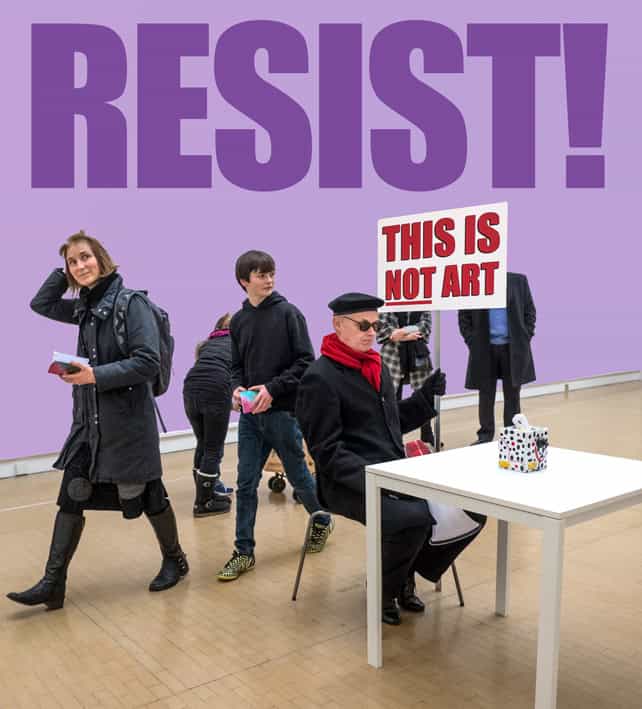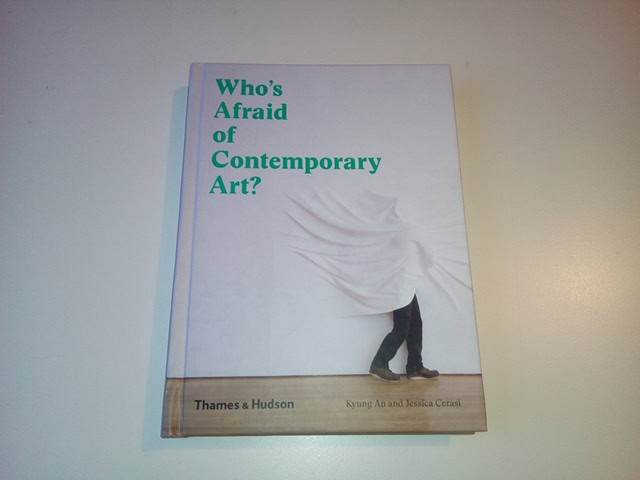
Conceptual art is God, argues Ivor Tymchak. But he also argues that God does not exist…
Ladies and gentlemen, I’m going to perpetrate some conceptual art right here in this article. The usual tradition of reviewing a book is to read the whole book first and then pass judgement on the sum of its parts. That is bourgois. I will review this book from one small part of it – a sentence only. From that sentence I will simply extrapolate the greater whole of the book as I imagine it to be not as it pretends to be.

The sentence will be chosen at random using Artist’s Breath and a Dust Mote. Here goes…
Completely naked, I’ve opened the book at random on a page and now I exhale my Artist’s breath, (except my breath is emanating from the orifice at the other end of the tube) and I waft a dust mote (whose molecules may or may not have been part of Marina Abramovic’s pubic hair) and I observe it land on a sentence.
As a method for reviewing a book I think you would agree this is pretty outlandish but it’s still not as outlandish as some of the literal shit that resides in some of the most prestigious galleries in the world.
Here is the chosen sentence:
“At any rate, for virtually anyone working in the art world, the ‘Is it art?’ question is boring and irrelevant. The real question is: ‘Is it any good?’”
OK, let’s go to work and interpret this sentence.
“Is it any good?” As what? If a child approaches the teacher with a blank sheet of paper and asks “Is it any good?’ how is the teacher supposed to respond? She either has to say, “Yes, everything can be good” or ask “Any good as what?”
Let’s consider the pile of bricks by Carl Andre. It asks the question “Am I any good?”
Well, as bricks, yes. As bricks, you’re brilliant because with bricks you can build cathedrals and other structures which come under the umbrella term of architecture some of which is considered good and some, not so good.
But as art? Well, if I want to attribute a qualitative measure to this question I have to compare you with something – other art presumably. ‘Is it any good?’ asks for measurement. To measure something you need a standard so that others don’t have to invent a standard of their own because if we all did that there would be no ‘standard’ by definition. And galleries mainly exist to show ‘the best of’ certain works.
So what standard are we to use to cope with this question – presumably the one used to define good art? This now demands the question “how do we define what is good art or not?” or to use the shorter version “what is art?”
Damn! We’re back to that question again. It’s as bad as the question “does god exist?” (The answer is no, by the way – he/she/it does not exist.)
Perhaps the real question that no one is prepared to ask is: “Can you draw?”
The discussion of “Is it Art?” Versus “Is it good Art?” is fundamental. Until 1917 it was something of a moot point, art tended to be recognised as art. Then Duchamp had to go and show his urinal, the trend of the “ready-made” began and art has never been the same since.
When I teach this question of “Is it art?” My example runs thus…
When I’m in my studio and I make a cup of coffee and put it on a plinth, IT IS ART! However, when I’m in my studio and I make a cup of coffee and drink it, it’s just a cup of coffee. The basic question surrounding the first example is not “Is it Art?” Because the simple answer is “Yes, coz I say so and I’m an artist” end of discussion. Not very useful or informative. The real question is therefore, “Is it any good?” In this case the answer is probably “No” it’s just a cup of coffee being art coz I say it is.
However, art is all about context, either socially, culturally intellectually etc, and I could come up with any number of perfectly reasonable explanations as to why the cup of coffee might be “Good art”.
I agree though that there are a myriad of artists working today who utilise this process to make work, who are doing little more than restating Duchamp’s original thesis that anything can be art. This contemporary art is boring, and fundamentally uninteresting. In my opinion the last great pice of work in this style was “An Oak Tree” by Michael Craig Martin.
As an aside, it never ceases to amuse me that whenever this argument regarding the “Is it art?” question comes up, the default (every single time) example used is Carl Andres ” Tate Bricks”. For me this is the single fact required to make this piece of art one of the most significant in the last 70 years. A work, that hardly anyone has seen in real life, that the lay audience don’t know the context of, that is “just a pile of bricks” yet is THE go to example of modern art. Wow! That’s incredible, and makes the work incredible too.
Dom
Duchamp never showed that urinal. It’s a myth http://store.leeds.ac.uk/product-catalogue/fine-art/the-wild-pansy-press/duchamps-urinal-the-facts-behind-the-faade
Thanks for this link, Phil. Over the years I’d been picking up intimations from one or two sources that Elsa was the force behind the urinal stunt. I never realised that Duchamp’s duplicity was so thorough. Maybe he can be attributed with inventing the conceptual art form of lying about art?
Hi Phil
Thanks for the link, really interesting.
However, attribution of the “urinal” aside, the basic question regarding the definition of Art, is predicated on the concept invoked and subsequently developed that ready makes, found objects etc can be art. “Is it art” is fundamentally a small question to ask, because the answer is very basic. The question of quality is where all the interesting dialogue sits.
Thanks for commenting, Dom.
I mentioned the bricks because I remember the media furore when they were exhibited. I suspect a lot of artists got the message then that the more outrageous a piece was the more media coverage it got. This is not conducive to making good art.
Duchamp was a chess player (and also a bit of a plagiarist from what I can gather – it was a woman who came up with the readymades concept first) and he was playing the organisers of the exhibition in a game of cat-and-mouse he had devised. I liked his jokes but I wouldn’t call it art.
You haven’t explained how ‘good art’ is measured so the ‘Is it art?’ problem still exists. In the old days everyone accepted art as something that required the ability to draw. Today that measuring stick is considered outdated, probably because it takes a long time to master.
By the way, is my review a good review? If it isn’t, how do you decide this? The review is after all on on a plinth.
Hi Ivor
The definition of “good art” is almost undefinable, it still comes down ultimately to the eye of the beholder. You will like work I hate, and vice versa. This is, I think, where a great deal of the interest in art originates. Any definition of quality will always leave out some work liked and respected by some people and the definition would have to be constantly refined to cope with changing tastes in the public/market and in the social and cultural realm that creates art.
My point about Duchamp is that of course he “played” the gallery, but for a reason, in order to protest at what he considered was the stifling definition of good art by the establishment of the time. He literally broke the mold and art was never the same. The problem, as you point out, is that some artists today make art seemingly only to provoke similar reactions, which is unnecessary and dull.
My art teacher at school once said to me, after I’d told him I’d made a piece of work to “provoke a reaction”, that a punch in the face would provoke a reaction, but it wouldn’t be art.
Ultimately what I’m trying to say is that I think the “is it art” question is obsolete. Art is anything, literally anything, that an artist says it is. No one can argue with that point. The media use this question as an easy way to write about art, because to discuss if it’s any good is so much more complicated. The “is it art” question seems simple, so they can engage with it at that level. It is simple… If it’s been done by an artist, and they call it art, then it’s art. End of discussion.
Asking the harder question about its quality is where the interesting conversations lie. Conversations that will never end and hopefully never get boring, but they will ultimately never provide a straight forward, catch all, set of answers. But that’s the point.
I appreciate the point you’re making, Dominic and in relation to your comment about the media, it nearly always ducks the more complex (and therefore, interesting) questions. Complexity is not how the media works with any subject matter.
I had a stab at explaining how people appreciate art and it might go some way to explaining how to value art.
https://theculturevulture.co.uk/all/art-furnace-at-bettasocial-wharf-chambers-dec-17/